

Compact Muon Solenoid
LHC, CERN
| CMS-PAS-SMP-21-014 | ||
| Search for exclusive γγ→ WW and γγ→ ZZ production in final states with jets and forward protons | ||
| CMS Collaboration | ||
| March 2022 | ||
| Abstract: A search for anomalous γγ→ WW and γγ→ ZZ production, with intact forward protons reconstructed in Roman Pots, and both gauge bosons decaying to boosted and merged jets, is performed. The analysis is based on a sample of proton-proton collisions collected by the CMS experiment with √s= 13 TeV, corresponding to an integrated luminosity of 100 fb−1. No excess above the Standard Model background prediction is seen, and upper limits are set on cross sections in a fiducial region defined by diboson invariant mass m> 1 TeV and proton fractional momentum loss 0.04 <ξ< 0.20. The results are interpreted as new limits on dimension-6 and dimension-8 Anomalous Quartic Gauge Couplings. | ||
|
Links:
CDS record (PDF) ;
CADI line (restricted) ;
These preliminary results are superseded in this paper, Submitted to JHEP. The superseded preliminary plots can be found here. |
||
| Figures | |

png pdf |
Figure 1:
Schematic diagrams of γγ→ WW production with intact protons according to the Standard Model. |

png pdf |
Figure 1-a:
Schematic diagrams of γγ→ WW production with intact protons according to the Standard Model. |
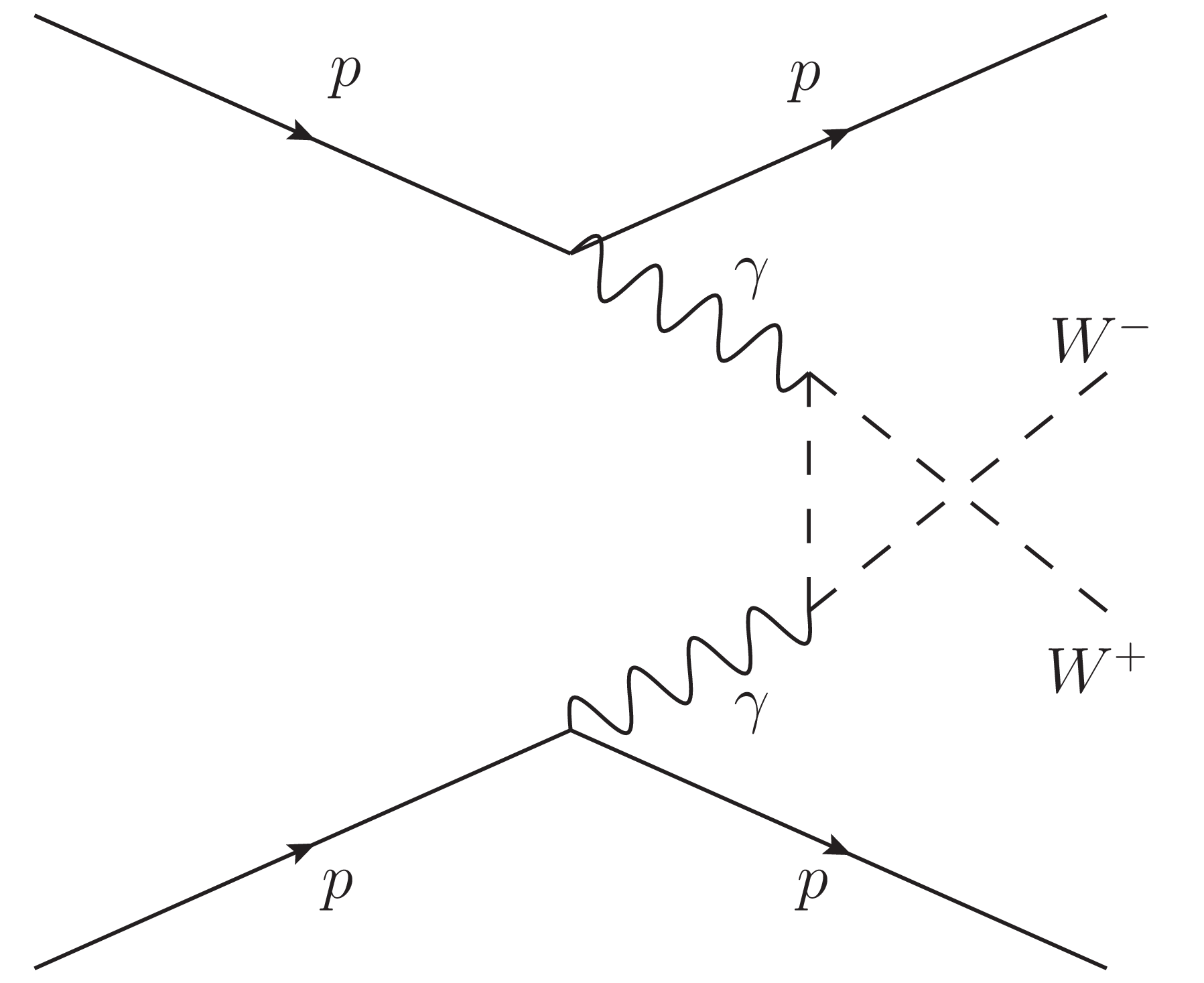
png pdf |
Figure 1-b:
Schematic diagrams of γγ→ WW production with intact protons according to the Standard Model. |
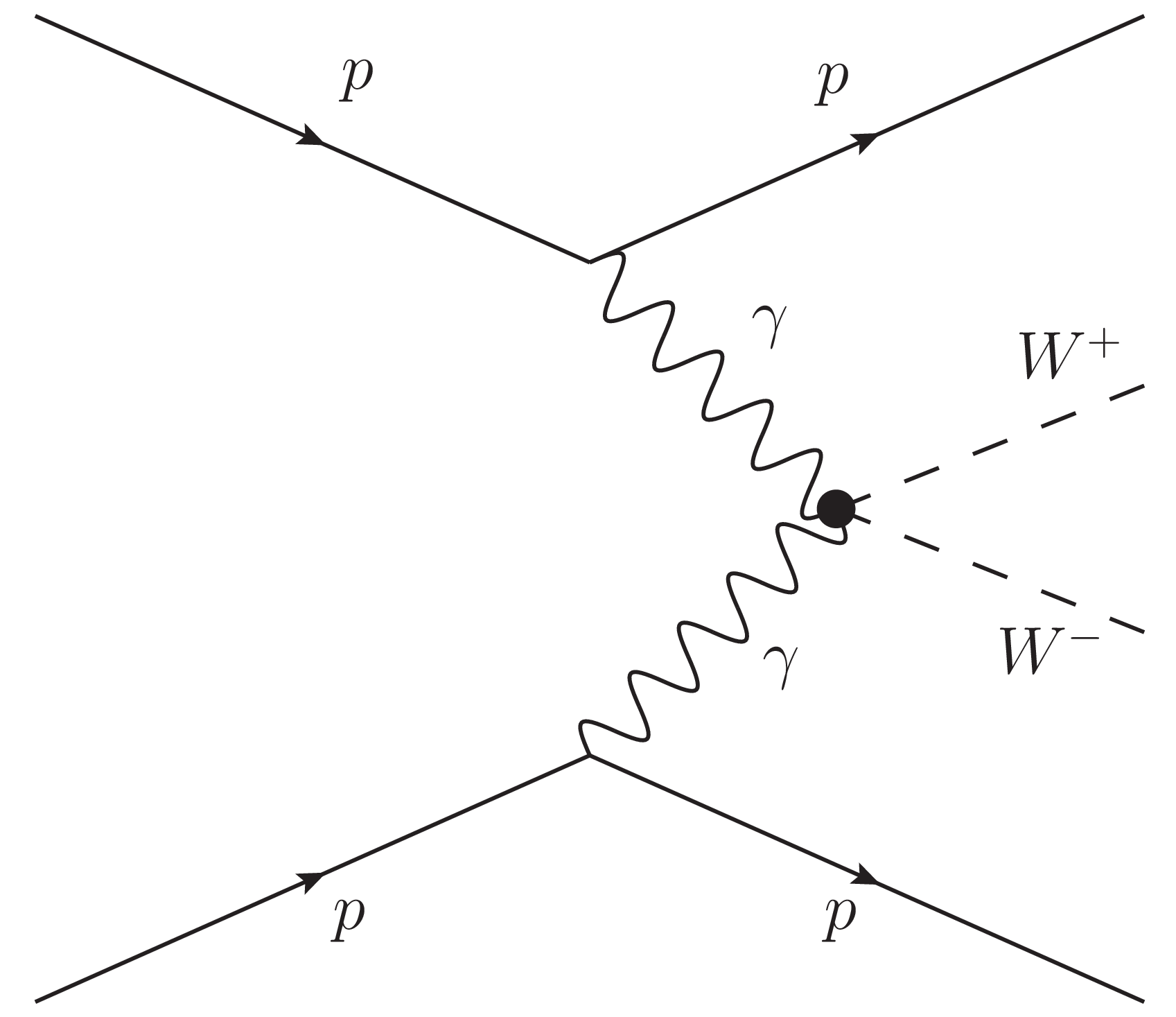
png pdf |
Figure 1-c:
Schematic diagrams of γγ→ WW production with intact protons according to the Standard Model. |
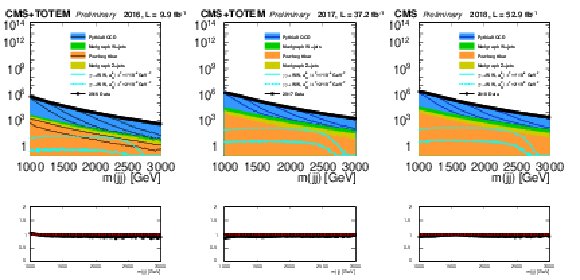
png pdf |
Figure 2:
Dijet invariant mass spectrum in data and simulation, for the years 2016 (left), 2017 (center), and 2018 (right). The upper plots show data compared to the stacked background predictions from simulation, the lower plots show the ratio of data to the sum of simulated backgrounds. The plots are shown at the pre-selection level, with no requirements on the protons, jet substructure, or dijet balance. Examples of simulated signals are shown for protons generated in the range of ξ=0.01−0.20. Only statistical uncertainties are shown. |
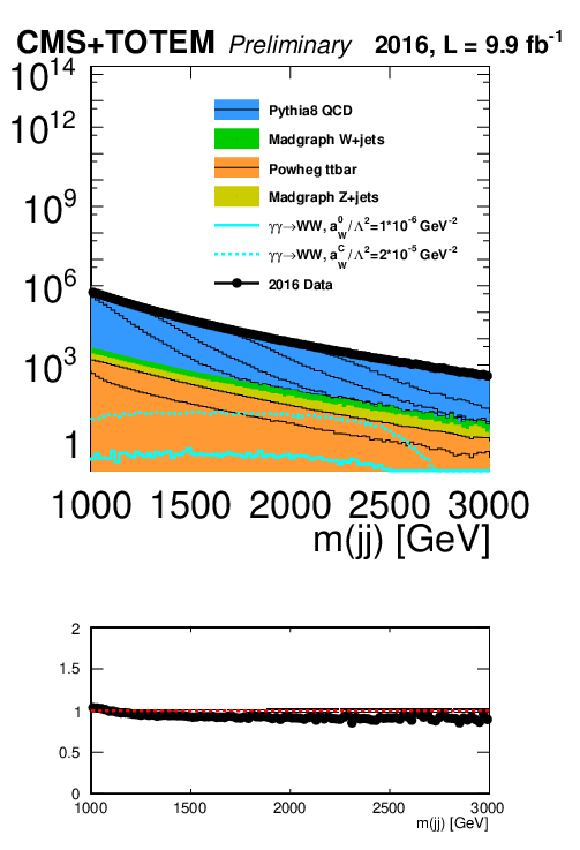
png pdf |
Figure 2-a:
Dijet invariant mass spectrum in data and simulation, for the years 2016 (left), 2017 (center), and 2018 (right). The upper plots show data compared to the stacked background predictions from simulation, the lower plots show the ratio of data to the sum of simulated backgrounds. The plots are shown at the pre-selection level, with no requirements on the protons, jet substructure, or dijet balance. Examples of simulated signals are shown for protons generated in the range of ξ=0.01−0.20. Only statistical uncertainties are shown. |

png pdf |
Figure 2-b:
Dijet invariant mass spectrum in data and simulation, for the years 2016 (left), 2017 (center), and 2018 (right). The upper plots show data compared to the stacked background predictions from simulation, the lower plots show the ratio of data to the sum of simulated backgrounds. The plots are shown at the pre-selection level, with no requirements on the protons, jet substructure, or dijet balance. Examples of simulated signals are shown for protons generated in the range of ξ=0.01−0.20. Only statistical uncertainties are shown. |

png pdf |
Figure 2-c:
Dijet invariant mass spectrum in data and simulation, for the years 2016 (left), 2017 (center), and 2018 (right). The upper plots show data compared to the stacked background predictions from simulation, the lower plots show the ratio of data to the sum of simulated backgrounds. The plots are shown at the pre-selection level, with no requirements on the protons, jet substructure, or dijet balance. Examples of simulated signals are shown for protons generated in the range of ξ=0.01−0.20. Only statistical uncertainties are shown. |

png pdf |
Figure 3:
Projection of the plane of leading (j1) versus subleading (j2) jet pruned masses, in simulated WW and ZZ signal events. |
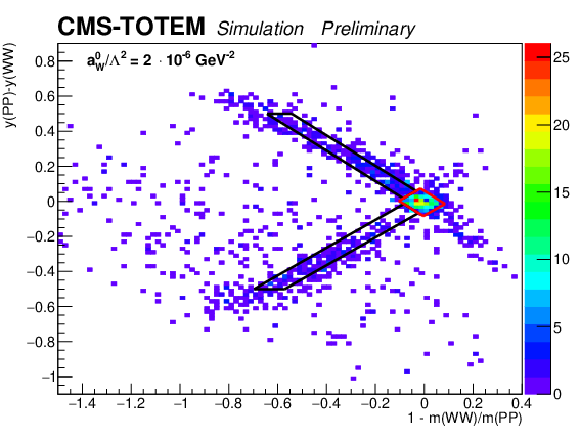
png pdf |
Figure 4:
Matching between the jets and protons, in invariant mass and rapidity, for simulated signal events in the WW region of pruned masses. The diamond-shaped area near 0,0 (signal region δ) corresponds to the case where both protons are correctly matched to the jets. The diagonal bands (signal region "o'') correspond to the case where one proton is correctly matched, and the second proton originates from a pileup interaction. |
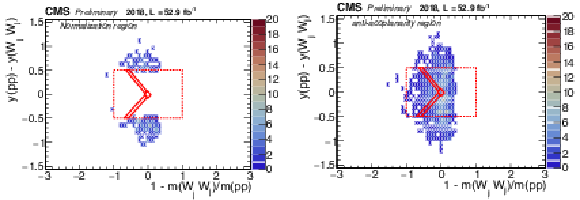
png pdf |
Figure 5:
Distribution of the 2018 data in the y(pp)−y(VV) vs. 1−m(VV)/m(pp) plane in the WW mass region. On the left, the normalization sample is shown, where all selections are applied, except that the region inside the dashed lines remains blinded. On the right, the anti-acoplanarity region is shown, where the acoplanarity requirement is inverted to select a background-dominated sample. The solid lines indicate the same signal regions as shown in Fig. xxxxx. In the right plot the area inside the solid lines corresponds to "Region B'', while the area outside the dashed lines corresponds to "Region C''. |
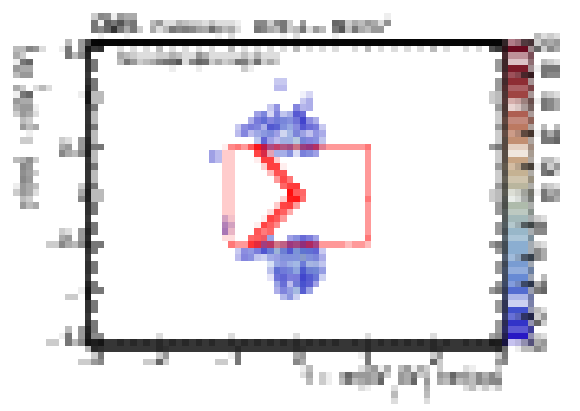
png pdf |
Figure 5-a:
Distribution of the 2018 data in the y(pp)−y(VV) vs. 1−m(VV)/m(pp) plane in the WW mass region. On the left, the normalization sample is shown, where all selections are applied, except that the region inside the dashed lines remains blinded. On the right, the anti-acoplanarity region is shown, where the acoplanarity requirement is inverted to select a background-dominated sample. The solid lines indicate the same signal regions as shown in Fig. xxxxx. In the right plot the area inside the solid lines corresponds to "Region B'', while the area outside the dashed lines corresponds to "Region C''. |

png pdf |
Figure 5-b:
Distribution of the 2018 data in the y(pp)−y(VV) vs. 1−m(VV)/m(pp) plane in the WW mass region. On the left, the normalization sample is shown, where all selections are applied, except that the region inside the dashed lines remains blinded. On the right, the anti-acoplanarity region is shown, where the acoplanarity requirement is inverted to select a background-dominated sample. The solid lines indicate the same signal regions as shown in Fig. xxxxx. In the right plot the area inside the solid lines corresponds to "Region B'', while the area outside the dashed lines corresponds to "Region C''. |

png pdf |
Figure 6:
Diboson invariant mass in data and simulation in the anti-acoplanarity region (a> 0.01), with no requirement on the proton matching. The plots from left to right are for the 2016, 2017, and 2018 data, respectively, with the WW region in the upper row and the ZZ region in the lower. Only statistical uncertainties are shown. |

png pdf |
Figure 6-a:
Diboson invariant mass in data and simulation in the anti-acoplanarity region (a> 0.01), with no requirement on the proton matching. The plots from left to right are for the 2016, 2017, and 2018 data, respectively, with the WW region in the upper row and the ZZ region in the lower. Only statistical uncertainties are shown. |

png pdf |
Figure 6-b:
Diboson invariant mass in data and simulation in the anti-acoplanarity region (a> 0.01), with no requirement on the proton matching. The plots from left to right are for the 2016, 2017, and 2018 data, respectively, with the WW region in the upper row and the ZZ region in the lower. Only statistical uncertainties are shown. |

png pdf |
Figure 6-c:
Diboson invariant mass in data and simulation in the anti-acoplanarity region (a> 0.01), with no requirement on the proton matching. The plots from left to right are for the 2016, 2017, and 2018 data, respectively, with the WW region in the upper row and the ZZ region in the lower. Only statistical uncertainties are shown. |

png pdf |
Figure 6-d:
Diboson invariant mass in data and simulation in the anti-acoplanarity region (a> 0.01), with no requirement on the proton matching. The plots from left to right are for the 2016, 2017, and 2018 data, respectively, with the WW region in the upper row and the ZZ region in the lower. Only statistical uncertainties are shown. |

png pdf |
Figure 6-e:
Diboson invariant mass in data and simulation in the anti-acoplanarity region (a> 0.01), with no requirement on the proton matching. The plots from left to right are for the 2016, 2017, and 2018 data, respectively, with the WW region in the upper row and the ZZ region in the lower. Only statistical uncertainties are shown. |

png pdf |
Figure 6-f:
Diboson invariant mass in data and simulation in the anti-acoplanarity region (a> 0.01), with no requirement on the proton matching. The plots from left to right are for the 2016, 2017, and 2018 data, respectively, with the WW region in the upper row and the ZZ region in the lower. Only statistical uncertainties are shown. |

png pdf |
Figure 7:
Observed data and expected number of background events in each signal region. A hypothetical AQGC signal is also shown. The histogram with solid lines indicates the number expected for only background, with uncertainties shown by the shaded band. The dashed-line histogram shows the number for background plus an assumed signal with aW0/Λ2= 5×10−6 GeV−2. |
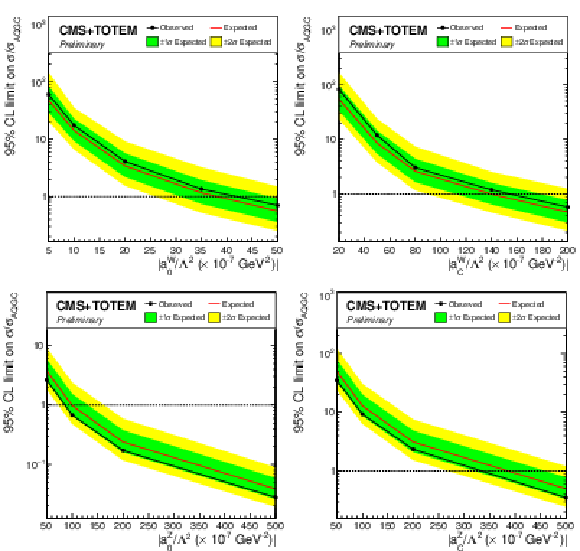
png pdf |
Figure 8:
Expected and observed upper limits on the AQGC operators aW0/Λ2 (upper left), aWC/Λ2 (upper right), aZ0/Λ2 (lower left), aZC/Λ2 (lower right), with no unitarization. |
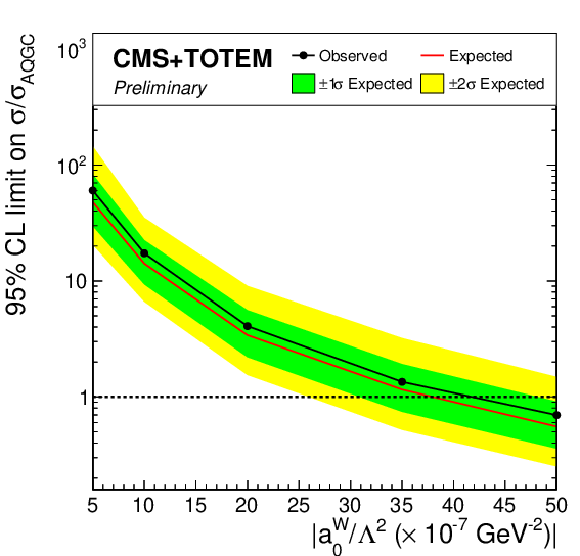
png pdf |
Figure 8-a:
Expected and observed upper limits on the AQGC operators aW0/Λ2 (upper left), aWC/Λ2 (upper right), aZ0/Λ2 (lower left), aZC/Λ2 (lower right), with no unitarization. |

png pdf |
Figure 8-b:
Expected and observed upper limits on the AQGC operators aW0/Λ2 (upper left), aWC/Λ2 (upper right), aZ0/Λ2 (lower left), aZC/Λ2 (lower right), with no unitarization. |

png pdf |
Figure 8-c:
Expected and observed upper limits on the AQGC operators aW0/Λ2 (upper left), aWC/Λ2 (upper right), aZ0/Λ2 (lower left), aZC/Λ2 (lower right), with no unitarization. |
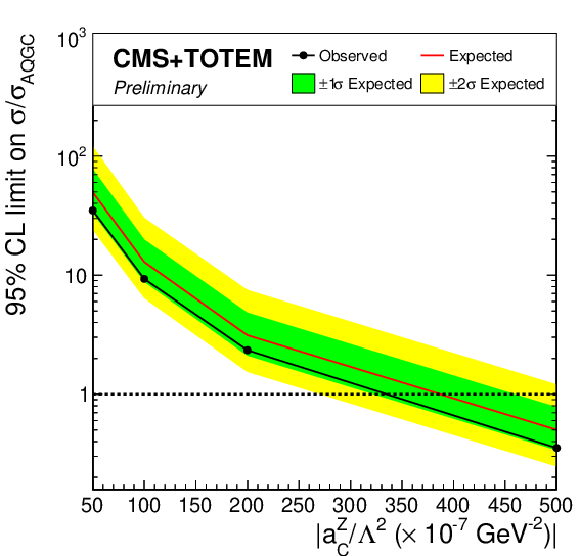
png pdf |
Figure 8-d:
Expected and observed upper limits on the AQGC operators aW0/Λ2 (upper left), aWC/Λ2 (upper right), aZ0/Λ2 (lower left), aZC/Λ2 (lower right), with no unitarization. |
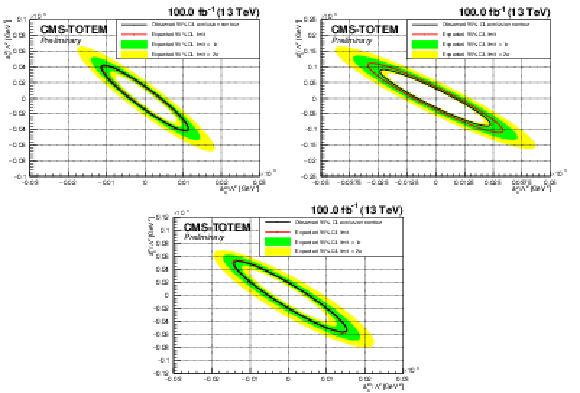
png pdf |
Figure 9:
Expected and observed limits in the two-dimensional plane of aW0/Λ2 vs. aWC/Λ2 (above left), aZ0/Λ2 vs. aZC/Λ2 (above right), and aW0/Λ2 vs. aWC/Λ2 with unitarization imposed by clipping the signal model at 1.4 TeV (below). |

png pdf |
Figure 9-a:
Expected and observed limits in the two-dimensional plane of aW0/Λ2 vs. aWC/Λ2 (above left), aZ0/Λ2 vs. aZC/Λ2 (above right), and aW0/Λ2 vs. aWC/Λ2 with unitarization imposed by clipping the signal model at 1.4 TeV (below). |

png pdf |
Figure 9-b:
Expected and observed limits in the two-dimensional plane of aW0/Λ2 vs. aWC/Λ2 (above left), aZ0/Λ2 vs. aZC/Λ2 (above right), and aW0/Λ2 vs. aWC/Λ2 with unitarization imposed by clipping the signal model at 1.4 TeV (below). |
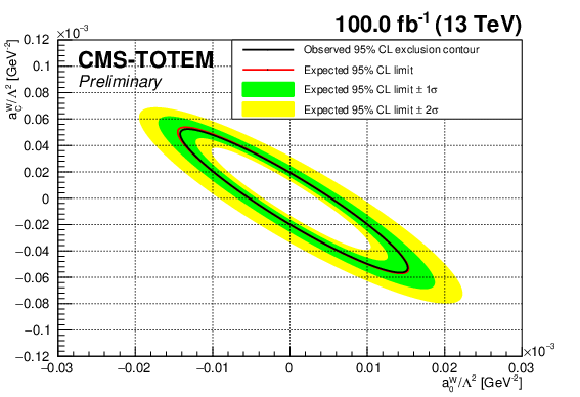
png pdf |
Figure 9-c:
Expected and observed limits in the two-dimensional plane of aW0/Λ2 vs. aWC/Λ2 (above left), aZ0/Λ2 vs. aZC/Λ2 (above right), and aW0/Λ2 vs. aWC/Λ2 with unitarization imposed by clipping the signal model at 1.4 TeV (below). |
| Tables | |

png pdf |
Table 1:
Background predictions from all methods, for the WW signal regions with fully ("region δ'') and partially ("region o'') reconstructed events. The mean value of the expected signal for one anomalous coupling point (aW0/Λ2= 5×10−6 GeV−2) is also shown for comparison. |

png pdf |
Table 2:
Background predictions from all methods, for the ZZ signal regions with fully ("region δ'') or partially ("region o'') reconstructed events. The mean value of the expected signal for one anomalous coupling point (aZ0/Λ2= 1×10−5 GeV−2) is also shown for comparison. |

png pdf |
Table 3:
Limits on LEP-like dimension-6 Anomalous Quartic Gauge Coupling parameters, with and without unitarization via a clipping procedure. |

png pdf |
Table 4:
Conversion of limits on aW0 to dimension-8 fM,i operators, using the assumption of vanishing WWZγ couplings to eliminate some parameters. When quoting limits on one of the operators, the other is fixed to zero. The results for |fM,0/Λ4| and |fM,4/Λ4| are shown with and without clipping of the signal model at 1.4 TeV, when the other parameter is fixed to the SM value of zero. |
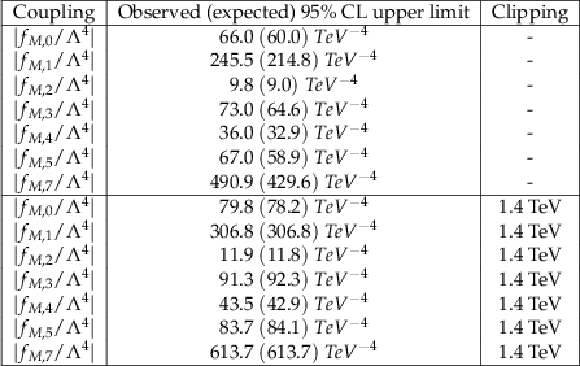
png pdf |
Table 5:
Conversion of limits on aW0 and aWC to dimension-8 fM,i operators, using the assumption that all fM,i except one are equal to zero. The results are shown with and without clipping of the signal model at 1.4 TeV. |
| Summary |
|
A first search for anomalous high-mass γγ→ WW and γγ→ ZZ production with reconstructed forward protons has been performed, in final states with the W or Z decaying to jets, using 100.0 fb−1 of data collected in 13 TeV proton-proton collisions. No significant excess over the Standard Model background prediction is found, The resulting limits are interpreted in terms of non-linear dimension-6, and linear dimension-8, anomalous quartic gauge couplings. The unitarized dimension-6 γγWW AQGC limits are approximately ∼15-20x more stringent than the limits obtained from the γγ→ WW process without proton tagging in LHC Run 1. The converted dimension-8 limits are close to those obtained from same-sign WW and WZ scattering at 13 TeV after unitarization, in the scenario where the WWZγ coupling is suppressed. The limits on γγZZ anomalous couplings are the first obtained though the exclusive γγ→ ZZ channel. New limits are placed on the fiducial cross section for TeV-scale γγ→ WW and γγ→ ZZ production with intact forward protons. |
| References | ||||
| 1 | M. Boonekamp et al. | FPMC: a generator for forward physics | 2011 | 1102.2531 |
| 2 | T. Pierzchala and K. Piotrzkowski | Sensitivity to anomalous quartic gauge couplings in photon-photon interactions at the LHC | NPPS 179-180 (2008) 257--264 | 0807.1121 |
| 3 | E. Chapon, C. Royon, and O. Kepka | Anomalous quartic W W γγ, Z Z γγ, and trilinear WW γ couplings in two-photon processes at high luminosity at the LHC | Physical Review D 81 (Apr, 2010) | 0912.5161 |
| 4 | M. Maniatis, A. von Manteuffel, and O. Nachtmann | Anomalous couplings in γγ→W+W− at LHC and ILC | NPPS 179-180 (2008) 104--108 | |
| 5 | R. L. Delgado, A. Dobado, M. J. Herrero, and J. J. Sanz-Cillero | One-loop γγ→ W+L W−L and γγ→ ZL ZL from the Electroweak Chiral Lagrangian with a light Higgs-like scalar | JHEP 07 (2014) 149 | 1404.2866 |
| 6 | S. Fichet and G. von Gersdorff | Anomalous gauge couplings from composite Higgs and warped extra dimensions | JHEP 03 (2014) 102 | 1311.6815 |
| 7 | R. S. Gupta | Probing Quartic Neutral Gauge Boson Couplings using diffractive photon fusion at the LHC | PRD 85 (2012) 014006 | 1111.3354 |
| 8 | R. L. Delgado et al. | Collider production of electroweak resonances from γγ states | JHEP 11 (2018) 010 | 1710.07548 |
| 9 | R. L. Delgado, A. Dobado, and F. J. Llanes-Estrada | Coupling WW, ZZ unitarized amplitudes to γγ in the TeV region | EPJC 77 (2017), no. 4, 205 | 1609.06206 |
| 10 | C. Baldenegro, G. Biagi, G. Legras, and C. Royon | Central exclusive production of W boson pairs in pp collisions at the LHC in hadronic and semi-leptonic final states | JHEP 12 (2020) 165 | 2009.08331 |
| 11 | G. Belanger et al. | Bosonic quartic couplings at LEP-2 | EPJC 13 (2000) 283--293 | hep-ph/9908254 |
| 12 | G. Belanger and F. Boudjema | gamma gamma ---> W+ W- and gamma gamma ---> Z Z as tests of novel quartic couplings | PLB 288 (1992) 210 | |
| 13 | O. J. P. Eboli, M. C. Gonzalez-Garcia, and J. K. Mizukoshi | p p ---> j j e+- mu+- nu nu and j j e+- mu-+ nu nu at O( alpha(em)**6) and O(alpha(em)**4 alpha(s)**2) for the study of the quartic electroweak gauge boson vertex at CERN LHC | PRD 74 (2006) 073005 | hep-ph/0606118 |
| 14 | O. J. P. Eboli, M. C. Gonzalez-Garcia, and S. M. Lietti | Bosonic quartic couplings at CERN LHC | PRD 69 (2004) 095005 | hep-ph/0310141 |
| 15 | O. J. P. \'Eboli and M. C. Gonzalez-Garcia | Classifying the bosonic quartic couplings | PRD 93 (2016), no. 9, 093013 | 1604.03555 |
| 16 | ATLAS Collaboration | Measurement of exclusive γγ→W+W− production and search for exclusive Higgs boson production in pp collisions at √s= 8 TeV using the ATLAS detector | PRD 94 (2016), no. 3, 032011 | 1607.03745 |
| 17 | CMS Collaboration | Study of Exclusive Two-Photon Production of W+W− in pp Collisions at √s= 7 TeV and Constraints on Anomalous Quartic Gauge Couplings | JHEP 07 (2013) 116 | CMS-FSQ-12-010 1305.5596 |
| 18 | CMS Collaboration | Evidence for exclusive γγ→W+W− production and constraints on anomalous quartic gauge couplings in pp collisions at √s= 7 and 8 TeV | JHEP 08 (2016) 119 | CMS-FSQ-13-008 1604.04464 |
| 19 | D0 Collaboration | Search for anomalous quartic WWγγ couplings in dielectron and missing energy final states in pˉp collisions at √s= 1.96 TeV | PRD 88 (2013) 012005 | 1305.1258 |
| 20 | ATLAS Collaboration | Observation of photon-induced W+W− production in pp collisions at √s= 13 TeV using the ATLAS detector | PLB 816 (2021) 136190 | 2010.04019 |
| 21 | CMS Collaboration | Measurements of production cross sections of WZ and same-sign WW boson pairs in association with two jets in proton-proton collisions at √s= 13 TeV | PLB 809 (2020) 135710 | CMS-SMP-19-012 2005.01173 |
| 22 | CMS Collaboration | Measurement of the electroweak production of Zγ and two jets in proton-proton collisions at √s= 13 TeV and constraints on anomalous quartic gauge couplings | PRD 104 (2021) 072001 | CMS-SMP-20-016 2106.11082 |
| 23 | CMS Collaboration | Observation of electroweak production of Wγ with two jets in proton-proton collisions at √s= 13 TeV | PLB 811 (2020) 135988 | CMS-SMP-19-008 2008.10521 |
| 24 | CMS Collaboration | Measurement of vector boson scattering and constraints on anomalous quartic couplings from events with four leptons and two jets in proton\textendashproton collisions at √s= 13 TeV | PLB 774 (2017) 682--705 | CMS-SMP-17-006 1708.02812 |
| 25 | CMS Collaboration | Measurements of the pp → W±γγ and pp → Zγγ cross sections at √s= 13 TeV and limits on anomalous quartic gauge couplings | JHEP 10 (2021) 174 | CMS-SMP-19-013 2105.12780 |
| 26 | CMS, TOTEM Collaboration | First search for exclusive diphoton production at high mass with tagged protons in proton-proton collisions at √s= 13 TeV | Oct, 2021. Submitted to PRL. All figures and tables can be found at http://cms-results.web.cern.ch/cms-results/public-results/publications/EXO-18-014 (CMS Public Pages) | 2110.05916 |
| 27 | CMS Collaboration | The CMS experiment at the CERN LHC | JINST 3 (2008) S08004 | CMS-00-001 |
| 28 | CMS, TOTEM Collaboration | CMS-TOTEM Precision Proton Spectrometer | CERN-LHCC-2014-021, TOTEM-TDR-003, CMS-TDR-13, September | |
| 29 | CMS Collaboration | Performance of the CMS Level-1 trigger in proton-proton collisions at √s= 13 TeV | JINST 15 (2020) P10017 | CMS-TRG-17-001 2006.10165 |
| 30 | CMS Collaboration | The CMS trigger system | JINST 12 (2017) P01020 | CMS-TRG-12-001 1609.02366 |
| 31 | CMS Collaboration | Precision luminosity measurement in proton-proton collisions at √s= 13 TeV in 2015 and 2016 at CMS | EPJC 81 (Apr, 2021) 800 | CMS-LUM-17-003 2104.01927 |
| 32 | CMS Collaboration | CMS luminosity measurement for the 2017 data-taking period at √s= 13 TeV | CMS-PAS-LUM-17-004 | CMS-PAS-LUM-17-004 |
| 33 | CMS Collaboration | CMS luminosity measurement for the 2018 data-taking period at √s= 13 TeV | CMS-PAS-LUM-18-002 | CMS-PAS-LUM-18-002 |
| 34 | T. Sjostrand et al. | An Introduction to PYTHIA 8.2 | CPC 191 (2015) 159--177 | 1410.3012 |
| 35 | CMS Collaboration | Event generator tunes obtained from underlying event and multiparton scattering measurements | EPJC 76 (2016), no. 3, 155 | CMS-GEN-14-001 1512.00815 |
| 36 | CMS Collaboration | Extraction and validation of a new set of CMS PYTHIA8 tunes from underlying-event measurements | The European Physical Journal C 80 (2019), no. 1 | CMS-GEN-17-001 1903.12179 |
| 37 | J. Alwall et al. | The automated computation of tree-level and next-to-leading order differential cross sections, and their matching to parton shower simulations | Journal of High Energy Physics 2014 (Jul, 2014) | 1405.0301v2 |
| 38 | S. Alioli et al. | Jet pair production in POWHEG | JHEP 04 (2011) 081 | 1012.3380 |
| 39 | S. Frixione, P. Nason, and C. Oleari | Matching NLO QCD computations with parton shower simulations: the POWHEG method | JHEP 11 (2007) 070 | 0709.2092 |
| 40 | P. Nason | A new method for combining NLO QCD with shower Monte Carlo algorithms | JHEP 11 (2004) 040 | hep-ph/0409146 |
| 41 | GEANT4 Collaboration | GEANT4--a simulation toolkit | NIMA 506 (2003) 250--303 | |
| 42 | CMS Collaboration | A multi-dimensional search for new heavy resonances decaying to boosted WW, WZ, or ZZ boson pairs in the dijet final state at 13 TeV | EPJC 80 (2020), no. 3, 237 | CMS-B2G-18-002 1906.05977 |
| 43 | M. Cacciari, G. P. Salam, and G. Soyez | The anti-kt jet clustering algorithm | JHEP 04 (2008) 063 | 0802.1189 |
| 44 | M. Cacciari, G. P. Salam, and G. Soyez | FastJet user manual | EPJC 72 (2012) 1896 | 1111.6097 |
| 45 | J. Thaler and K. Van Tilburg | Identifying boosted objects with N-subjettiness | JHEP 03 (2011) 015 | 1011.2268 |
| 46 | J. Dolen et al. | Thinking outside the ROCs: Designing Decorrelated Taggers (DDT) for jet substructure | JHEP 05 (2016) 156 | 1603.00027 |
| 47 | CMS, TOTEM Collaboration | Proton reconstruction with the Precision Proton Spectrometer in Run 2 | ||
| 48 | F. Nemes | LHC optics determination with proton tracks measured in the CT-PPS detectors in 2016, before TS2 | CERN-TOTEM-NOTE-2017-002, Mar | |
| 49 | J. Ka\vspar | Alignment of CT-PPS detectors in 2016, before TS2 | CERN-TOTEM-NOTE-2017-001, Mar | |
| 50 | L. Harland-Lang, V. Khoze, and M. G. Ryskin | Elastic photon-initiated production at the lhc: the role of hadron-hadron interactions | SciPost Physics 11 (Sep, 2021) | 2104.13392 |
| 51 | CMS Collaboration | Search for WWγ and WZγ production and constraints on anomalous quartic gauge couplings in pp collisions at √s= 8 TeV | PRD 90 (2014), no. 3, 032008 | CMS-SMP-13-009 1404.4619 |

|
Compact Muon Solenoid LHC, CERN |

|

|

|

|

|

|